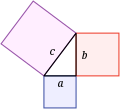
A | B | C | D | E | F | G | H | CH | I | J | K | L | M | N | O | P | Q | R | S | T | U | V | W | X | Y | Z | 0 | 1 | 2 | 3 | 4 | 5 | 6 | 7 | 8 | 9

| Geometry |
|---|
 |
| Geometers |
Euclidean geometry is a mathematical system attributed to ancient Greek mathematician Euclid, which he described in his textbook on geometry, Elements. Euclid's approach consists in assuming a small set of intuitively appealing axioms (postulates) and deducing many other propositions (theorems) from these. Although many of Euclid's results had been stated earlier,[1] Euclid was the first to organize these propositions into a logical system in which each result is proved from axioms and previously proved theorems.[2]
The Elements begins with plane geometry, still taught in secondary school (high school) as the first axiomatic system and the first examples of mathematical proofs. It goes on to the solid geometry of three dimensions. Much of the Elements states results of what are now called algebra and number theory, explained in geometrical language.[1]
For more than two thousand years, the adjective "Euclidean" was unnecessary because Euclid's axioms seemed so intuitively obvious (with the possible exception of the parallel postulate) that theorems proved from them were deemed absolutely true, and thus no other sorts of geometry were possible. Today, however, many other self-consistent non-Euclidean geometries are known, the first ones having been discovered in the early 19th century. An implication of Albert Einstein's theory of general relativity is that physical space itself is not Euclidean, and Euclidean space is a good approximation for it only over short distances (relative to the strength of the gravitational field).[3]
Euclidean geometry is an example of synthetic geometry, in that it proceeds logically from axioms describing basic properties of geometric objects such as points and lines, to propositions about those objects. This is in contrast to analytic geometry, introduced almost 2,000 years later by René Descartes, which uses coordinates to express geometric properties by means of algebraic formulas.
The Elements
The Elements is mainly a systematization of earlier knowledge of geometry. Its improvement over earlier treatments was rapidly recognized, with the result that there was little interest in preserving the earlier ones, and they are now nearly all lost.
There are 13 books in the Elements:
Books I–IV and VI discuss plane geometry. Many results about plane figures are proved, for example, "In any triangle, two angles taken together in any manner are less than two right angles." (Book I proposition 17) and the Pythagorean theorem "In right-angled triangles the square on the side subtending the right angle is equal to the squares on the sides containing the right angle." (Book I, proposition 47)
Books V and VII–X deal with number theory, with numbers treated geometrically as lengths of line segments or areas of surface regions. Notions such as prime numbers and rational and irrational numbers are introduced. It is proved that there are infinitely many prime numbers.
Books XI–XIII concern solid geometry. A typical result is the 1:3 ratio between the volume of a cone and a cylinder with the same height and base. The platonic solids are constructed.
Axioms

Euclidean geometry is an axiomatic system, in which all theorems ("true statements") are derived from a small number of simple axioms. Until the advent of non-Euclidean geometry, these axioms were considered to be obviously true in the physical world, so that all the theorems would be equally true. However, Euclid's reasoning from assumptions to conclusions remains valid independently from the physical reality.[4]
Near the beginning of the first book of the Elements, Euclid gives five postulates (axioms) for plane geometry, stated in terms of constructions (as translated by Thomas Heath):[5]
- Let the following be postulated:
- To draw a straight line from any point to any point.
- To produce (extend) a finite straight line continuously in a straight line.
- To describe a circle with any centre and distance (radius).
- That all right angles are equal to one another.
- : That, if a straight line falling on two straight lines make the interior angles on the same side less than two right angles, the two straight lines, if produced indefinitely, meet on that side on which the angles are less than two right angles.
Although Euclid explicitly only asserts the existence of the constructed objects, in his reasoning he also implicitly assumes them to be unique.
The Elements also include the following five "common notions":
- Things that are equal to the same thing are also equal to one another (the transitive property of a Euclidean relation).
- If equals are added to equals, then the wholes are equal (Addition property of equality).
- If equals are subtracted from equals, then the differences are equal (subtraction property of equality).
- Things that coincide with one another are equal to one another (reflexive property).
- The whole is greater than the part.
Modern scholars agree that Euclid's postulates do not provide the complete logical foundation that Euclid required for his presentation.[6] Modern treatments use more extensive and complete sets of axioms.
Parallel postulate
To the ancients, the parallel postulate seemed less obvious than the others. They aspired to create a system of absolutely certain propositions, and to them, it seemed as if the parallel line postulate required proof from simpler statements. It is now known that such a proof is impossible since one can construct consistent systems of geometry (obeying the other axioms) in which the parallel postulate is true, and others in which it is false.[7] Euclid himself seems to have considered it as being qualitatively different from the others, as evidenced by the organization of the Elements: his first 28 propositions are those that can be proved without it.
Many alternative axioms can be formulated which are logically equivalent to the parallel postulate (in the context of the other axioms). For example, Playfair's axiom states:
- In a plane, through a point not on a given straight line, at most one line can be drawn that never meets the given line.
The "at most" clause is all that is needed since it can be proved from the remaining axioms that at least one parallel line exists.

Methods of proof
Euclidean Geometry is constructive. Postulates 1, 2, 3, and 5 assert the existence and uniqueness of certain geometric figures, and these assertions are of a constructive nature: that is, we are not only told that certain things exist, but are also given methods for creating them with no more than a compass and an unmarked straightedge.[8] In this sense, Euclidean geometry is more concrete than many modern axiomatic systems such as set theory, which often assert the existence of objects without saying how to construct them, or even assert the existence of objects that cannot be constructed within the theory.[9] Strictly speaking, the lines on paper are models of the objects defined within the formal system, rather than instances of those objects. For example, a Euclidean straight line has no width, but any real drawn line will have. Though nearly all modern mathematicians consider nonconstructive methods just as sound as constructive ones, Euclid's constructive proofs often supplanted fallacious nonconstructive ones—e.g., some of the Pythagoreans' proofs that involved irrational numbers, which usually required a statement such as "Find the greatest common measure of ..."[10]
Euclid often used proof by contradiction. Euclidean geometry also allows the method of superposition, in which a figure is transferred to another point in space. For example, proposition I.4, side–angle–side congruence of triangles, is proved by moving one of the two triangles so that one of its sides coincides with the other triangle's equal side, and then proving that the other sides coincide as well. Some modern treatments add a sixth postulate, the rigidity of the triangle, which can be used as an alternative to superposition.[11]
Notation and terminology
Naming of points and figures
Points are customarily named using capital letters of the alphabet. Other figures, such as lines, triangles, or circles, are named by listing a sufficient number of points to pick them out unambiguously from the relevant figure, e.g., triangle ABC would typically be a triangle with vertices at points A, B, and C.
Complementary and supplementary angles
Angles whose sum is a right angle are called complementary. Complementary angles are formed when a ray shares the same vertex and is pointed in a direction that is in between the two original rays that form the right angle. The number of rays in between the two original rays is infinite.
Angles whose sum is a straight angle are supplementary. Supplementary angles are formed when a ray shares the same vertex and is pointed in a direction that is in between the two original rays that form the straight angle (180 degree angle). The number of rays in between the two original rays is infinite.
Modern versions of Euclid's notation
In modern terminology, angles would normally be measured in degrees or radians.
Modern school textbooks often define separate figures called lines (infinite), rays (semi-infinite), and line segments (of finite length). Euclid, rather than discussing a ray as an object that extends to infinity in one direction, would normally use locutions such as "if the line is extended to a sufficient length", although he occasionally referred to "infinite lines". A "line" in Euclid could be either straight or curved, and he used the more specific term "straight line" when necessary.
Some important or well known results
-
The pons asinorum or bridge of asses theorem states that in an isosceles triangle, α = β and γ = δ.
-
The triangle angle sum theorem states that the sum of the three angles of any triangle, in this case angles α, β, and γ, will always equal 180 degrees.
-
The Pythagorean theorem states that the sum of the areas of the two squares on the legs (a and b) of a right triangle equals the area of the square on the hypotenuse (c).
-
Thales' theorem states that if AC is a diameter, then the angle at B is a right angle.Zdroj:https://en.wikipedia.org?pojem=Euclidean_geometry
Text je dostupný za podmienok Creative Commons Attribution/Share-Alike License 3.0 Unported; prípadne za ďalších podmienok. Podrobnejšie informácie nájdete na stránke Podmienky použitia.
Antropológia
Aplikované vedy
Bibliometria
Dejiny vedy
Encyklopédie
Filozofia vedy
Forenzné vedy
Humanitné vedy
Knižničná veda
Kryogenika
Kryptológia
Kulturológia
Literárna veda
Medzidisciplinárne oblasti
Metódy kvantitatívnej analýzy
Metavedy
Metodika
Text je dostupný za podmienok Creative
Commons Attribution/Share-Alike License 3.0 Unported; prípadne za ďalších
podmienok.
Podrobnejšie informácie nájdete na stránke Podmienky
použitia.
www.astronomia.sk | www.biologia.sk | www.botanika.sk | www.dejiny.sk | www.economy.sk | www.elektrotechnika.sk | www.estetika.sk | www.farmakologia.sk | www.filozofia.sk | Fyzika | www.futurologia.sk | www.genetika.sk | www.chemia.sk | www.lingvistika.sk | www.politologia.sk | www.psychologia.sk | www.sexuologia.sk | www.sociologia.sk | www.veda.sk I www.zoologia.sk




